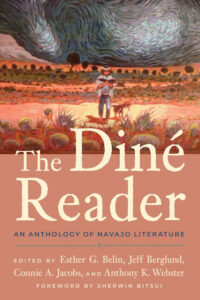Reviewed by Debbie Reese
Review Source: American Indians in Children’s Literature
Book Author: Esther G. Belin, Jeff Berglund, Connie A. Jacobs
In 2021, two terrific anthologies were published. First was When the Light of the World Was Subdued, Our Songs Came Through: A Norton Anthology of Native Nations Poetry (edited by Joy Harjo). Harjo’s anthology has writers from many different nations. I recommend you get a copy of it. Second is The Diné Reader. I recommend you get a copy of it, too, because it gives you depth about one nation.
Let’s start with Shonto Begay’s cover art. He is known in children’s literature for two books he wrote and illustrated: Ma’ii and Cousin Horned Toad (1992), and Navajo Visions and Voices Across the Mesa (1995). The title of the art on the cover of The Diné Reader is “With Glowing Words.” We see a Diné person, reading. In the interview of him on page 182, he said:
“When I paint people reading, it’s also beyond what the picture is, it keeps going on. It’s an interpretation of an interpretation of a reader.”
As I think about that, I wonder how high school students will interpret what they find in The Diné Reader. Who that reader is and what they’ve read will shape their interpretations of the poems and stories in the book. Continue reading on American Indians in Children’s Literature.

The Diné Reader by Esther G. Belin, Jeff Berglund, Connie A. Jacobs
Published by University of Arizona Press on April 20, 2021
Genres: American Indians First Nations Metis Inuit
Pages: 432
Reading Level: Adults
ISBN: 9780816542888
Review Source: American Indians in Children's Literature
Publisher's Synopsis: 2022 Before Columbus Foundation American Book Award Winner
The Diné Reader: An Anthology of Navajo Literature is unprecedented. It showcases the breadth, depth, and diversity of Diné creative artists and their poetry, fiction, and nonfiction prose. This wide-ranging anthology brings together writers who offer perspectives that span generations and perspectives on life and Diné history. The collected works display a rich variety of and creativity in themes: home and history; contemporary concerns about identity, historical trauma, and loss of language; and economic and environmental inequalities.
The Diné Reader developed as a way to demonstrate both the power of Diné literary artistry and the persistence of the Navajo people. The volume opens with a foreword by poet Sherwin Bitsui, who offers insight into the importance of writing to the Navajo people. The editors then introduce the volume by detailing the literary history of the Diné people, establishing the context for the tremendous diversity of the works that follow, which includes free verse, sestinas, limericks, haiku, prose poems, creative nonfiction, mixed genres, and oral traditions reshaped into the written word.
This volume combines an array of literature with illuminating interviews, biographies, and photographs of the featured Diné writers and artists. A valuable resource to educators, literature enthusiasts, and beyond, this anthology is a much-needed showcase of Diné writers and their compelling work. The volume also includes a chronology of important dates in Diné history by Jennifer Nez Denetdale, as well as resources for teachers, students, and general readers by Michael Thompson. The Diné Reader is an exciting convergence of Navajo writers and artists with scholars and educators.

Leave a Reply